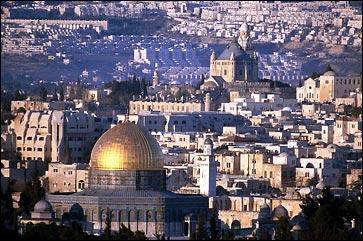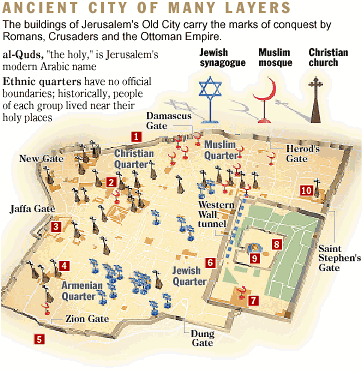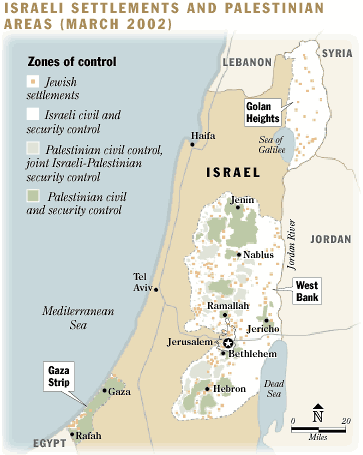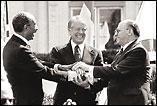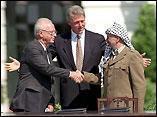 |
 |
|
||||||||
|
Sunday, May 12, 2002 The peace process Negotiations and the war of words Peace between Israel and Arabs has been elusive. Each side has lists of historic wrongs to be righted, claims to be defended and icons to be protected — and on key issues, both sides are intransigent. Talks have held promise of solutions, but true peace has always fallen victim to mutual mistrust and finger-pointing.
Three barriers to Israeli-Palestinian peace
Jerusalem is considered holy by three religions that make up more than half of the world's population: Judaism, Christianity and Islam. In the most dramatic example of how religious claims to the city literally overlap, Islam's Al-Aqsa mosque and the nearby Dome of the Rock sit atop the site that held the Jews' Second Temple before Romans destroyed it. A remaining wall of the second temple, revered by Jews as the Western (Wailing) Wall, is a stone's throw from the place where Muslim worshippers congregate for prayers at the Al-Aqsa Mosque. The 1947 U.N. proposal to divide the area into Jewish and Arab nations called for Jerusalem to be under international control. This vision was never realized. The Arabs rejected the U.N. proposal and declared war, while the Jews accepted it and declared statehood. In the fighting that ensued, Jerusalem was divided east and west between Jordan and Israeli. Israel took control of Jerusalem in the Six-Day War of 1967 and has held the city since. Israel claims it as its "eternal" capital, though most nations' embassies are in Tel Aviv. Israel has opposed any re-division of Jerusalem. Palestinians have said they cannot accept a final settlement with Israel that does not include Jerusalem as their capital. In peace talks in 2000-01, the idea of a Palestinian capital in east Jerusalem, along with some sort of Muslim sovereignty over the Al-Aqsa Mosque and the Dome of the Rock, was discussed but not finalized.
PALESTINIAN REFUGEES
Israelis maintain that letting in all refugees who wish to return would overwhelm the Jewish nature of the country and also present an unbearable security problem. Palestinians maintain that U.N. General Assembly resolutions affirm their right to return to their homeland, particularly Resolution 194, passed in 1948 to deal with the refugee problem and other issues. In part, Resolution 194 said: "... Refugees wishing to return to their homes and live at peace with their neighbors should be permitted to do so at the earliest practicable date, and that compensation should be paid for the property of those choosing not to return and for loss of or damage to property which, under principles of international law or in equity, should be made good by the Governments or authorities responsible." Israelis say a key phrase in the resolution is "live in peace." The Arab countries at the time refused to recognize the state of Israel, and Israel maintained that any group that refused to recognize Israel's right to exist would not live in peace. Today, only Jordan and Egypt have recognized Israel, and it was not until the mid-1990s that the Palestine Liberation Organization removed anti-Israeli wording from its charter. Israel, in peace talks with Palestinians in 2000 and 2001, reportedly was willing to accept only a token number of refugees perhaps 10,000. They envisioned reparations for the others, to be paid by other nations. Supporters of Israel argue that about as many Jewish refugees resulted from the 1948 war as Palestinian about 700,000 for each side. The Jewish refugees fled Palestinian lands and other Arab states during the fighting. Israel eagerly accepted the Jewish refugees while the Arab states, except Jordan, refused the Palestinian refugees, many of whom have remained in refugee camps for generation after generation. The Palestinian argument is simple: Resolution 194 says they have the right to return to their homes, and if they don't wish to return, they are due compensation. And they argue that under the U.N.'s 1948 Universal Declaration of Human Rights, it is a basic right of a people to live in their homeland.
THE JEWISH SETTLEMENTS
To Palestinians, these settlements, begun after the 1967 war, represent a direct affront to their sovereignty and suggest that the Israeli government is trying to subvert a basic premise of the Oslo Agreement: that the Palestinians will be granted control over the areas in which they are the dominant population.
Since the 1993 Oslo agreement, settlement population in the West Bank has doubled and is now at about 200,000. In all, there are an estimated 400,000 Israelis in settlements in the West Bank, Gaza Strip and in Arab east Jerusalem. The Mitchell Report, commissioned by President Clinton to look into the causes of the upsurge in Mideast violence that began in September 2000, cited the settlements as a primary cause of violence and an obstacle to peace. Israel, the April 2001 report said, "should give careful consideration to whether settlements ... are valuable bargaining chips for future negotiations or provocations likely to preclude the onset of productive talks." The report also noted that many leading nations consider the settlements to be illegal under the Oslo Agreement and the Fourth Geneva Convention, which prohibits an occupying power from creating settlements on occupied territory before a conflict has ended. The United States has long promoted a freeze on settlement expansion, though it has stopped short of calling settlements illegal. The settlements are seen by extremely religious Jews as confirmation of their inviolable, God-given right to live in areas thought to have been controlled by Jews in biblical times. Also, the settlements, particularly those in the Jordan Valley, are protected by Israeli soldiers and settler defense networks. They are seen by Israel as an important first line of defense.
Copyright © 2002 The Seattle Times Company
|
|
||||||||||||||||||||||||||||||||||
|
Two Peoples, One Land | Reader comments | Credits seattletimes.com home |
